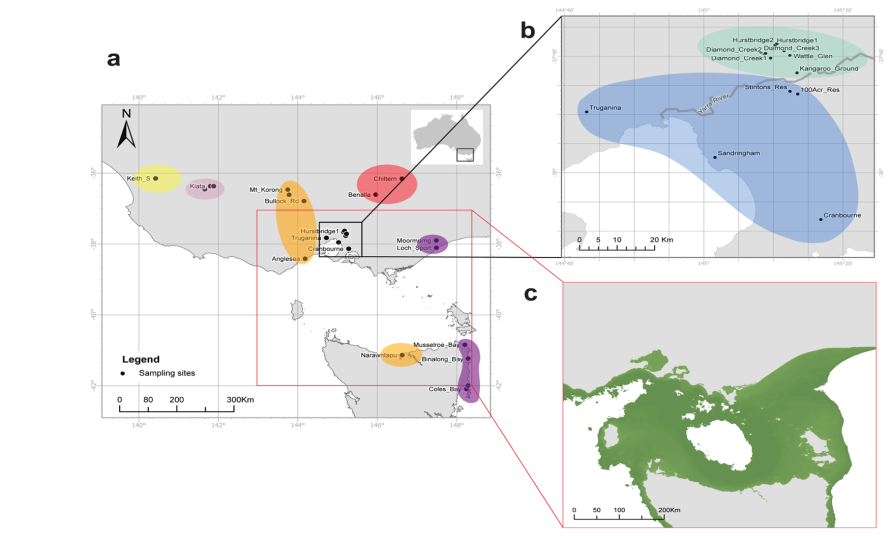
The wingless grasshopper that could cross Bass Strait, but not the Yarra River
Hiromi Yagui, Michael Kearney & Ary Hoffmann
Most grasshoppers can fly and some, notably locusts, can travel thousands of kilometres.
However, there is a whole family of grasshoppers in Australia that can’t fly at all, and they are not very good at hopping either. These are the morabine (or ‘matchstick’) grasshoppers, comprising around 240 species that occur only in Australia.

The Larapuna grasshopper, Vandiemenella viatica, is one of the few matchstick grasshoppers that is present in Victoria, including Melbourne. It is also the only representative from Tasmania.
We wanted to know how this feeble little grasshopper moved across Victoria and Tasmania over the past few tens of thousands of years.
Signatures of their movement can be found in their DNA.
Using new genomic approaches, we found evidence of two genetically distinguishable groups in Tasmania, one occurring along much of the east coast of Tasmania, including the Bay of Fires area in the north east and Freycinet Peninsula towards the middle of the east coast, and another occurring in the north central area at Narawntapu National Park.
Our genomic data published in the journal Molecular Ecology shows that the Narawntapu grasshoppers are closely related to ones found in coastal Victoria west of Melbourne, like those from Anglesea.
On the other hand, the populations from the east coast of Tasmania are distant from these but are instead closely related to coastal Gippsland populations, including Loch Sport (see map below).
When compared to Victorian populations, the Tasmanian grasshoppers have a low level of genetic variation which is indicative of small population sizes in the past.
 Summary of genetic data showing a) closely related groups across south-eastern Australia, b) genetic subgroups around the Melbourne area, and c) the land bridge (green) between Tasmania and mainland Australia when sea level was 78 metres lower than today (about 11-12 thousand years ago). Data source: Beaman, R.J. 2022. Note how there are two mainland groups related to two Tasmanian groups (orange and pink shading) and also that there are two groups in the Melbourne area.
Summary of genetic data showing a) closely related groups across south-eastern Australia, b) genetic subgroups around the Melbourne area, and c) the land bridge (green) between Tasmania and mainland Australia when sea level was 78 metres lower than today (about 11-12 thousand years ago). Data source: Beaman, R.J. 2022. Note how there are two mainland groups related to two Tasmanian groups (orange and pink shading) and also that there are two groups in the Melbourne area.So, we suspect that these populations managed to move along the land bridge across the Bass Strait (the Bassian Land Bridge) which existed most recently around 18,000 years ago, reflecting a decrease in sea levels connected to periods of glaciation at a global scale.
This is an impressive feat for a species that can only hop short distances of 10 to 20 centimetres at a time (in favourable conditions). This grasshopper also typically requires open space (so it can warm up) as well as daisies (or other forbs) and bushes for food.
The species nevertheless covered a distance of more than 370 kilometres from the Anglesea area, or over 300 kilometres from the Gippsland area.
This would need to have been achieved in the period when the land bridge existed and suitable vegetation was present – a likely window of several thousand years.
As well as documenting this amazing migration with genomic data, we were also able to show that the Melbourne populations were split into two different groups.
One of these was found north of the Yarra River in places like Diamond Creek and Hurstbridge. The other was found south of the Yarra and included populations from Sandringham and Cranbourne as well as Park Orchards (which is close to Diamond Creek but south of the Yarra).
It seems that these wingless grasshoppers have been unable to cross the Yarra despite making it all the way to Tasmania.

However, this might change as human activity inadvertently starts to spread them, perhaps through the movement of soil or vegetation across Melbourne.
These types of DNA-based findings are of practical importance.
In restoring urban ecosystems, there’s increasing interest in re-establishing populations of insects like grasshoppers that form an important part of the natural landscape.
Although the Larapuna grasshopper was formerly widespread across the wider Melbourne area, it now has a restricted and patchy distribution where it is often barely hanging on in the face of urban development.
But restoration and revegetation projects provide an opportunity to re-establish it again across the region and beyond, and we have released more than 3,000 individual grasshoppers across urban Melbourne using revegetated sites and small remnants as habitats.
When introducing grasshoppers, it’s important to be aware of the genetic uniqueness of local populations when identifying source populations for reintroduction. Knowing this means the unique patterns of relatedness among populations could be maintained into the future.
This also applies when restoring populations that are destroyed by catastrophes like bushfires.
Larapuna grasshoppers are not the only insect species with a limited ability to travel (low dispersal) – many other flightless insects exist and form an important component of the food web in an environment.
 Restoration and revegetation projects are an opportunity to re-establish several species of matchstick grasshopper. Picture: Michael Kearney
Restoration and revegetation projects are an opportunity to re-establish several species of matchstick grasshopper. Picture: Michael KearneyWe know very little about how other low dispersal species are structured genetically across the landscape and how these are linked to climatic processes from the past.
The more we learn about their past adventures across Australia, the better we will be able to conserve them in the future.
Banner: Hiromi Yagui
This article was first published on Pursuit. Read the original article.